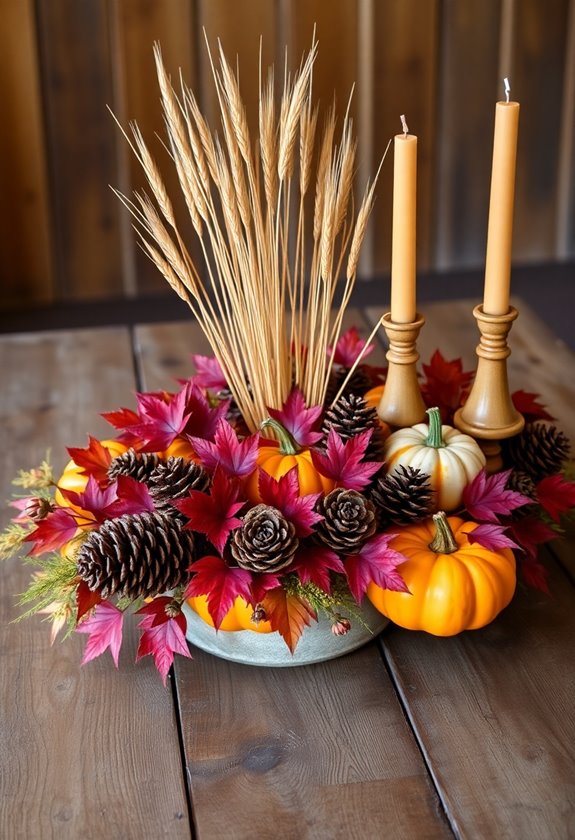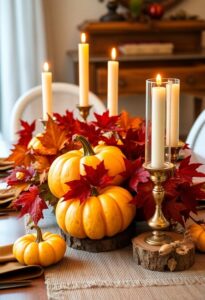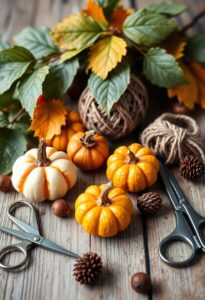You’ll love how natural materials bring authentic textures, seasonal fragrances, and cost-effective beauty to your Thanksgiving table that artificial decorations simply can’t match. Pine cones, acorns, and fresh gourds offer unique character while filling your dining space with inviting woody and spice scents. You’re also making an environmentally conscious choice since these materials decompose naturally, connect you to harvest traditions, and cost nothing when gathered from your own backyard. Discover how these simple elements create unforgettable holiday memories.
Design Highlights
- Natural materials offer authentic textures and unique imperfections that artificial decorations cannot replicate, creating more visually appealing centerpieces.
- Pine cones, cinnamon sticks, and fresh herbs provide inviting seasonal fragrances that enhance the dining experience and engage multiple senses.
- Gathering materials from nature like fallen leaves, acorns, and branches creates cost-effective centerpieces while reducing environmental waste.
- Using gourds, wheat stalks, and natural elements connects families to historical harvest traditions and the original spirit of Thanksgiving.
- Creating handcrafted centerpieces with family fosters personal satisfaction, lasting memories, and meaningful holiday experiences together.
Authentic Textures That Artificial Materials Cannot Replicate
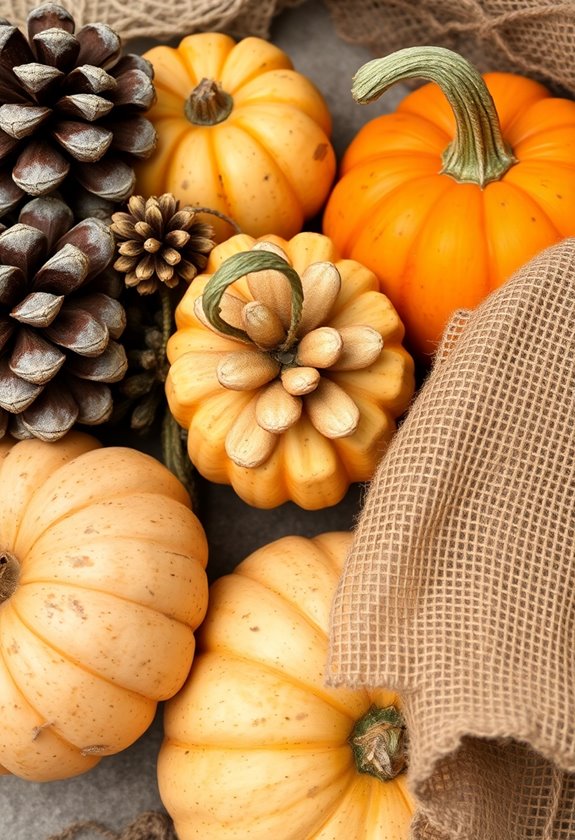
When you run your fingers across a real pinecone’s weathered scales or feel the smooth, cool surface of an acorn you’ve just plucked from your backyard, you’ll instantly understand why artificial materials simply can’t compete. There’s something magical about the way natural elements tell their own stories through touch.
I’ve watched guests at my Thanksgiving table become mesmerized by the rough bark of birch branches, running their thumbs along the papery layers that peel away like ancient scrolls. You can’t fake that kind of character. Real gourds have bumps, dents, and imperfections that make each one unique—unlike their plastic counterparts that look suspiciously identical.
The waxy coating on fresh cranberries catches candlelight differently than synthetic berries ever could. Even dried corn husks crinkle with an authenticity that brings back childhood memories of autumn farms. These textures create conversations, spark curiosity, and connect us to nature’s honest beauty. Incorporating natural materials in decor not only enhances the aesthetic but also promotes a sense of warmth and comfort in your space.
Seasonal Fragrances That Enhance the Dining Experience
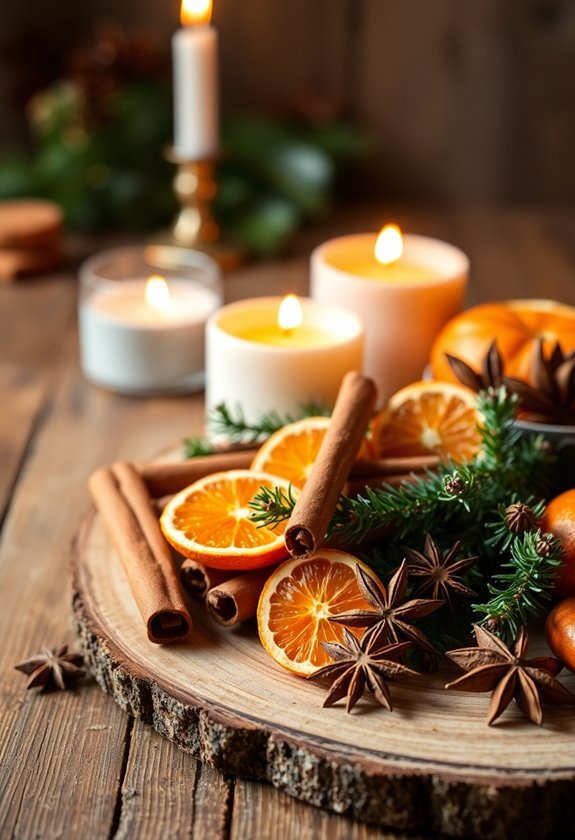
Beyond their incredible textures, natural materials fill your dining room with fragrances that transform your Thanksgiving gathering into a true sensory celebration. When I first discovered this magic, I was filming a family documentary and noticed how pine cones from our backyard made everyone pause and smile—their woody scent instantly transported us to cozy cabin memories.
You’ll love how cinnamon sticks release warm spice notes that complement your turkey perfectly. Fresh rosemary sprigs add an earthy herbaceous aroma that makes guests feel instantly welcomed. Orange slices and apple wedges create sweet, citrusy bursts that remind everyone of homemade pies cooling on windowsills. Incorporating festive kitchen decor ideas can further enhance the atmosphere and make your gathering even more memorable.
The challenge isn’t finding these materials—it’s resisting the urge to use too many! I learned this lesson when my over-enthusiastic eucalyptus arrangement overpowered Grandma’s famous stuffing. Now I balance three complementary scents maximum, creating layers of fragrance that enhance rather than compete with your delicious feast.
Cost-Effective Solutions Using Free Natural Resources

Since Thanksgiving falls during nature’s most generous season, you’ll discover that your yard and neighborhood offer an incredible treasure trove of free centerpiece materials. Last year, I learned this lesson while frantically searching for decorations on a tight budget – sometimes the best solutions are literally right outside your door.
Start with fallen leaves in brilliant oranges, reds, and golds. They’re absolutely free and create stunning bases for any arrangement. Pine cones scattered beneath trees become instant rustic accents, while bare branches add elegant height to your display.
Nature provides the perfect autumn palette – vibrant fallen leaves, weathered pine cones, and graceful bare branches transform into elegant centerpiece foundations.
Don’t overlook those colorful gourds growing wild in vacant lots or ask neighbors with gardens – most people are happy to share their extras. Even weeds like dried Queen Anne’s lace create beautiful, delicate textures. Additionally, consider incorporating Thanksgiving hallway decor ideas into your overall theme to enhance the festive atmosphere.
The real magic happens when you combine these elements creatively. You’ll save money while crafting something uniquely yours, and honestly, your guests will never guess you spent nothing on materials.
Environmental Benefits of Choosing Sustainable Decorations
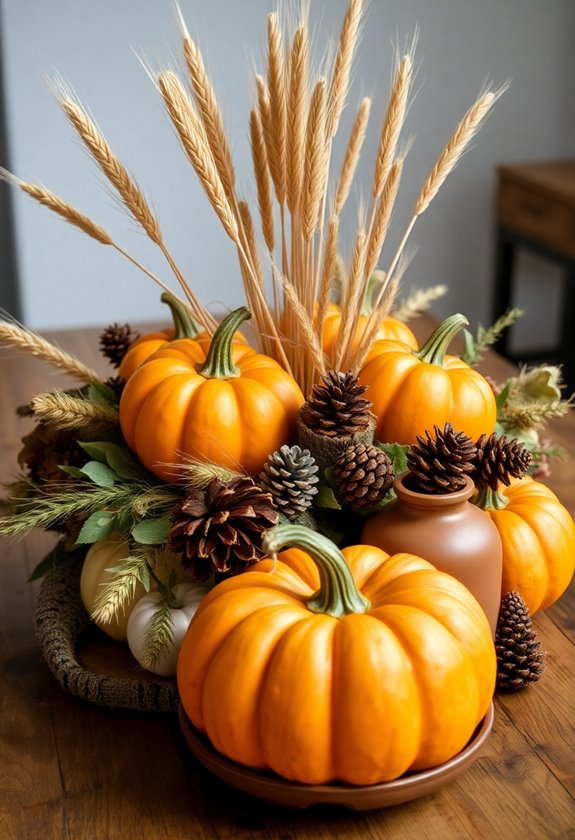
Choosing natural materials for your Thanksgiving centerpiece isn’t just smart for your wallet – it’s one of the easiest ways to help our planet while creating something beautiful. When you skip plastic decorations, you’re avoiding materials that’ll sit in landfills for centuries. Instead, your pinecones, acorns, and fallen leaves will naturally decompose after the holidays.
I’ve learned that nature’s decorations don’t require energy-intensive manufacturing or harmful chemicals. You’re literally walking outside and gathering what’s already there – no factories, no shipping trucks, no plastic packaging. It’s incredibly satisfying knowing your centerpiece has zero carbon footprint. Additionally, using natural materials not only enhances the aesthetic of your garden but also supports local ecosystems.
After Thanksgiving, you can compost everything or simply scatter it back in your yard. Compare that to store-bought decorations that often break after one season and end up in the trash. Your natural centerpiece becomes part of the earth again, feeding next year’s plants. That’s what I call full-circle decorating.
Symbolic Connection to Thanksgiving’s Harvest Traditions
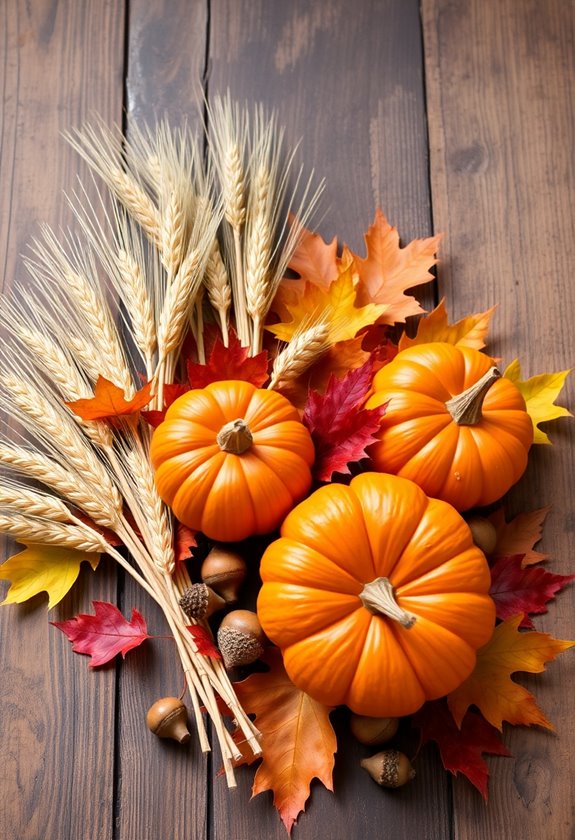
When you place gourds, wheat stalks, and autumn leaves on your table, you’re connecting with traditions that stretch back to America’s first harvest celebrations. I’ve always felt something magical about arranging these same materials our ancestors used centuries ago – it’s like holding hands across time.
Think about it: those early settlers didn’t have plastic pumpkins or artificial corn. They decorated with what nature provided, celebrating abundance after months of uncertainty. When you choose real pine cones, acorns, and dried corn husks, you’re honoring that same spirit of gratitude. Thanksgiving kitchen decor essentials can enhance this connection to nature.
My grandmother taught me this lesson while we gathered apples for her Thanksgiving display. “These aren’t just decorations,” she’d say, polishing each one carefully. “They’re reminders of what we’re thankful for.” Every natural element tells a story – the persimmon’s sweetness after frost, the pumpkin’s journey from seed to harvest. You’re not just decorating; you’re participating in history.
Versatility in Design Options With Natural Elements
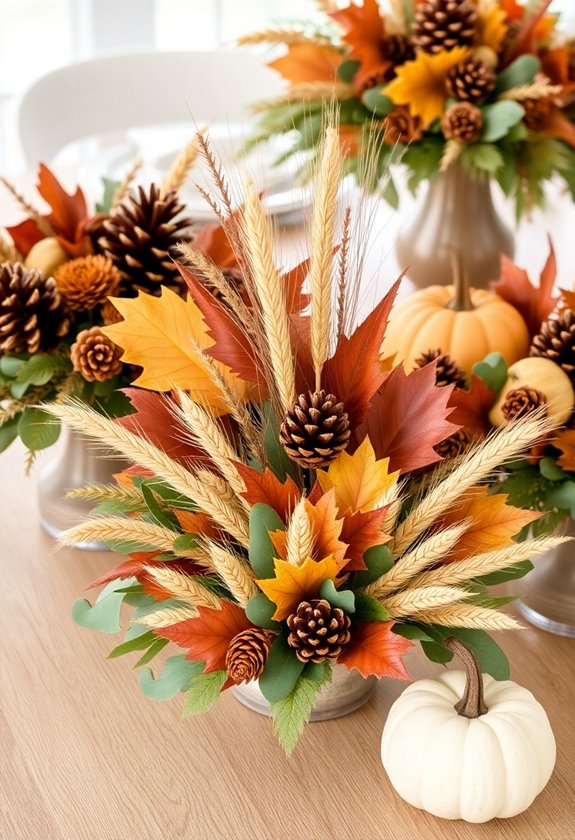
Beyond their historical significance, natural materials offer you an incredible playground of creative possibilities that’ll make your centerpiece uniquely yours. I’ve discovered that pinecones can become elegant candle holders, while acorns transform into charming place card holders with just a tiny drill bit and steady hands—though I’ll admit, my first attempt looked more like acorn confetti!
You can arrange wheat stalks in tall glass vases for dramatic height, or weave them into rustic placemats. Colorful gourds work beautifully as individual candle holders or grouped together for visual impact. Autumn leaves become stunning table runners when pressed between wax paper, and branches create gorgeous backdrops for smaller elements.
The best part? You’re not locked into one style. Mix mini pumpkins with eucalyptus for modern farmhouse vibes, or combine dried corn husks with berries for traditional charm. Each natural element adapts to your vision, whether you’re going rustic, elegant, or somewhere wonderfully in between.
Easy Customization Based on Regional Availability
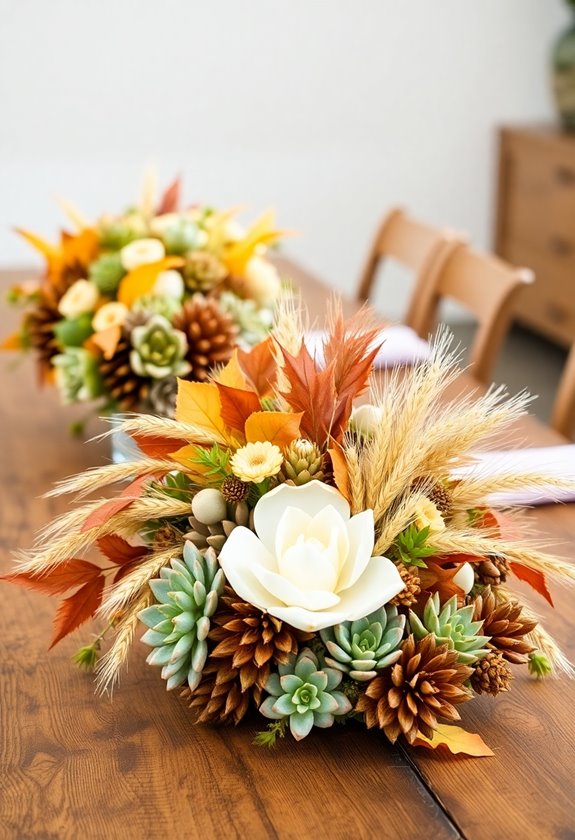
What’s growing right outside your door might be the secret ingredient to creating the most authentic Thanksgiving centerpiece possible. You’ll discover that using local materials isn’t just convenient—it’s like telling your own unique story through natural elements.
Living in the Pacific Northwest? Those vibrant maple leaves and douglas fir branches will create a completely different vibe than someone in Texas using mesquite pods and prickly pear. I’ve learned that embracing what’s available nearby actually makes your centerpiece more meaningful, not less creative.
You can easily swap expensive store-bought items for free treasures from your backyard. Pine cones replace costly decorative balls, while local berries add pops of color that complement your region’s natural palette. This approach reminds me of indie filmmaking—working with what you’ve got often produces the most authentic results. Your guests will appreciate the personal touch that reflects where you actually live.
Creating Memorable Sensory Experiences for Guests
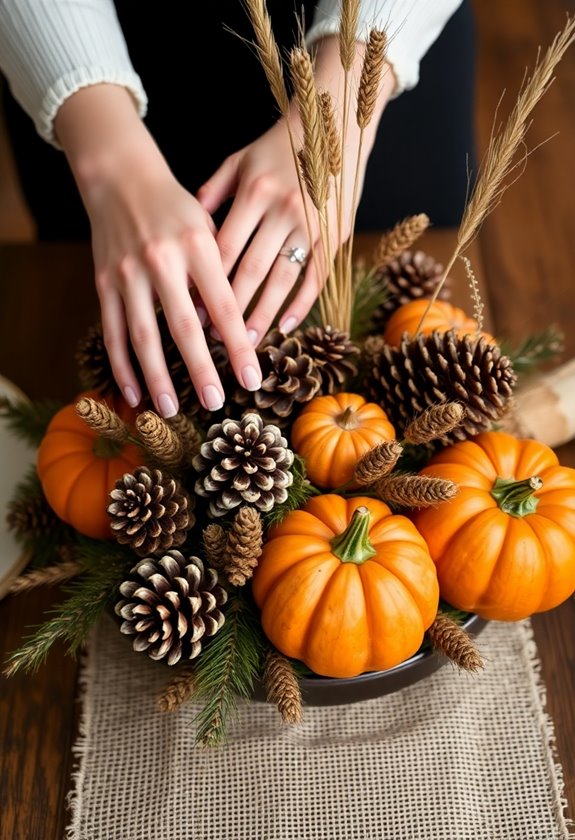
Since your centerpiece will sit at the heart of your Thanksgiving gathering, you’ll want to engage all five senses to create an experience that lingers in your guests’ memories long after dessert. Natural materials deliver this beautifully—imagine the rich scent of pine boughs mixing with cinnamon sticks, or the satisfying crunch of acorns as curious fingers explore your arrangement.
I’ve watched guests gravitate toward tables where they can touch weathered bark, smell fresh herbs, and hear the gentle rustle of dried leaves. There’s something magical about incorporating rosemary sprigs that release their fragrance when brushed, or adding small gourds with interesting textures that beg to be handled.
Visual appeal comes naturally with autumn’s golden palette, while taste can join the party through edible elements like cranberries or herb garnishes. These sensory layers transform your centerpiece from mere decoration into an interactive experience that sparks conversation and creates lasting memories.
Long-Lasting Appeal That Ages Gracefully

While store-bought decorations often look tired after just a few days, natural materials actually become more beautiful as they age—much like how my grandmother’s weathered apple crates grew more charming with each passing season. You’ll discover that pinecones develop richer patinas, pumpkins gain character through subtle color changes, and dried leaves create gorgeous rustling sounds that plastic never could.
I’ve learned this lesson the hard way after countless film shoots where artificial props looked increasingly fake under studio lights. Natural elements, however, told stories through their imperfections. Your wheat stalks will develop golden undertones, while acorns deepen to warm mahogany shades. Even if your centerpiece lasts through December, it’ll continue evolving beautifully.
The best part? You won’t stress about keeping everything “perfect.” Nature handles the aging process gracefully, creating an effortlessly elegant look that actually improves with time—something your guests will definitely notice and appreciate.
Personal Satisfaction From Handcrafted Holiday Displays
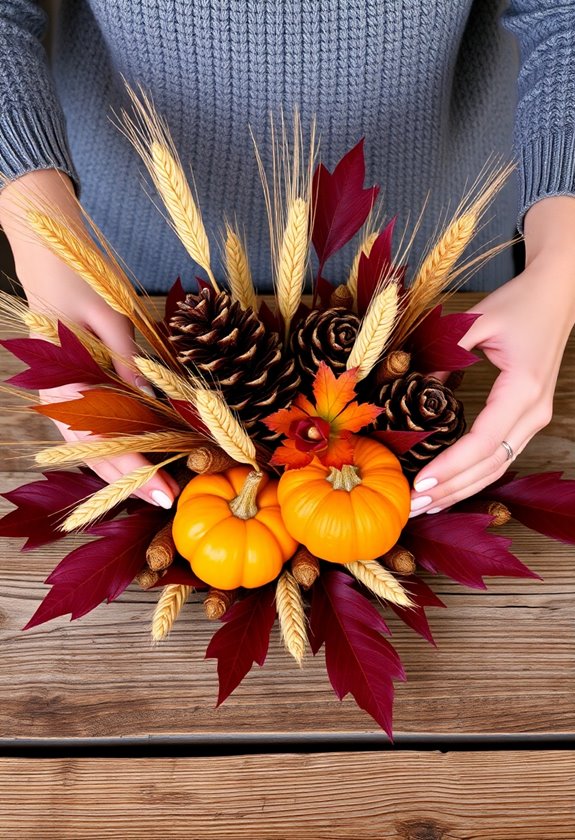
After years of rushing through holiday preparations with store-bought everything, I discovered something magical happens when you create your own centerpiece with your bare hands. You’ll feel an unexpected sense of pride watching your family admire something you crafted yourself—it’s like directing your first successful film scene.
When you arrange those golden gourds and crimson leaves, you’re not just decorating; you’re connecting with generations who celebrated harvests before us. Your kids will remember helping you gather acorns more than any expensive decoration you could’ve bought. There’s something deeply satisfying about stepping back and thinking, “I made this beautiful thing.”
The best part? Every imperfection tells your story. That slightly crooked branch or uneven pumpkin placement becomes part of your family’s unique Thanksgiving memory. You’re creating tradition, not just following it. Trust me, the personal investment makes your table infinitely more meaningful than any Pinterest-perfect store display ever could.
Frequently Asked Questions
How Do I Preserve Natural Materials to Last Through the Entire Holiday Season?
You’ll want to start by gently cleaning your materials, then let them dry completely. I’ve learned that glycerin works wonders for preserving leaves and small branches—just soak them for a few days. For pinecones and acorns, a light coat of clear spray sealant does the trick. Keep everything away from direct heat sources, and mist lightly when they start looking dry. Trust me, these simple steps will keep your centerpiece gorgeous!
What Natural Materials Are Safe to Use Around Pets and Small Children?
You’ll want to avoid anything toxic lurking in your beautiful display. Skip eucalyptus, holly berries, and mistletoe—they’re gorgeous but dangerous if nibbled. Instead, choose pet-safe options like wheat stalks, corn husks, pine cones, and pumpkins. Fresh apples, pears, and cotton bolls work wonderfully too. I’ve learned the hard way that curious cats don’t read warning labels! Always research each element before decorating, because your family’s safety trumps any centerpiece’s beauty.
How Far in Advance Can I Prepare My Natural Thanksgiving Centerpiece?
You can prepare your natural centerpiece 2-3 days ahead, though I’ve learned timing matters. Fresh flowers and delicate leaves should wait until the day before, but sturdy elements like pinecones, branches, and gourds can be arranged earlier. I always prep my base and gather materials first, then add fresh touches last. Store everything in a cool spot, and mist lightly if needed. Trust me, this approach saves major stress on Thanksgiving morning!
Which Natural Materials Work Best in Homes With Allergies or Sensitivities?
You’ll want to stick with low-pollen options like pinecones, acorns, and dried wheat stalks – they’re practically allergy-proof! I’ve learned that eucalyptus and lavender, while gorgeous, can trigger sensitivities. Skip fresh flowers entirely and go for preserved leaves, birch branches, and mini pumpkins instead. These materials won’t release irritating particles into your air, so everyone can actually enjoy dinner without sneezing through your beautiful centerpiece.
What Tools and Supplies Do I Need to Create Natural Centerpieces?
Last year, I scrambled around my garage looking for floral foam, only to discover I’d forgotten the basics! You’ll need sharp pruning shears for clean cuts, floral wire for securing stems, and a sturdy base like a wooden tray or wicker basket. Grab some moss to hide mechanics, small glass votive holders, and maybe twine for rustic touches. Don’t forget a spray bottle—keeping everything fresh matters more than perfect arrangement!

